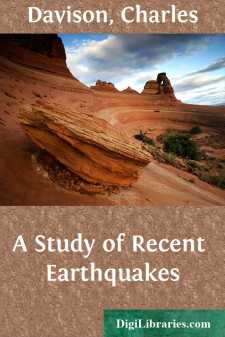Categories
- Antiques & Collectibles 13
- Architecture 36
- Art 48
- Bibles 22
- Biography & Autobiography 813
- Body, Mind & Spirit 142
- Business & Economics 28
- Children's Books 17
- Children's Fiction 14
- Computers 4
- Cooking 94
- Crafts & Hobbies 4
- Drama 346
- Education 46
- Family & Relationships 57
- Fiction 11829
- Games 19
- Gardening 17
- Health & Fitness 34
- History 1377
- House & Home 1
- Humor 147
- Juvenile Fiction 1873
- Juvenile Nonfiction 202
- Language Arts & Disciplines 88
- Law 16
- Literary Collections 686
- Literary Criticism 179
- Mathematics 13
- Medical 41
- Music 40
- Nature 179
- Non-Classifiable 1768
- Performing Arts 7
- Periodicals 1453
- Philosophy 64
- Photography 2
- Poetry 896
- Political Science 203
- Psychology 42
- Reference 154
- Religion 513
- Science 126
- Self-Help 84
- Social Science 81
- Sports & Recreation 34
- Study Aids 3
- Technology & Engineering 59
- Transportation 23
- Travel 463
- True Crime 29
A Study of Recent Earthquakes
by: Charles Davison
Categories:
Description:
Excerpt
CHAPTER I.
INTRODUCTION.
I propose in this book to describe a few of the more important earthquakes that have occurred during the last half century. In judging of importance, the standard which I have adopted is not that of intensity only, but rather of the scientific value of the results that have been achieved by the study of the shocks. Even with this reservation, the number of earthquakes that might be included is considerable; and I have therefore selected those which seem to illustrate best the different methods of investigation employed by seismologists, or which are of special interest owing to the unusual character of their phenomena or to the light cast by them on the nature and origin of earthquakes in general.
Thus, the Neapolitan earthquake possesses interest from a historical point of view; it is the first earthquake in the study of which modern scientific methods were employed. The Ischian earthquakes are described as examples of those connected with volcanic action; the Andalusian earthquake is chiefly remarkable for the recognition of the unfelt earth-waves; that of Charleston for the detection of the double epicentre and the calculation of the velocity with which the vibrations travelled. In the Riviera earthquake are combined the principal features of the last two shocks with several phenomena of miscellaneous interest, especially those connected with its submarine foci. The Japanese earthquake is distinguished from others by its extraordinary fault-scarp and the very numerous shocks that followed it. The Hereford earthquake is a typical example of a twin earthquake, and provided many observations on the sound phenomena; while the Inverness earthquakes are important on account of their connection with the growth of a well-known fault. The great Indian earthquake owns few, if any, rivals within historical times, whether we consider the intensity of the disturbance or the diversity and interest of the phenomena displayed by it—the widespread changes in the earth's crust, both superficial and deep-seated, and the tracking of the unfelt pulsations completely round the globe.
TERMS AND DEFINITIONS.
Some terms are of such frequent use in describing earthquakes that it will be convenient to group them here for reference, others more rarely employed being introduced as they are required.
An earthquake is caused by a sudden displacement of the material which composes the earth's interior. The displacement gives rise to series of waves, which are propagated outwards in all directions, and which, when they reach the surface, produce the sensations known to us as those of an earthquake.
The region within which the displacement occurs is sometimes called the hypocentre, but more frequently the seismic focus or simply the focus. The portion of the earth's surface which is vertically above the seismic focus is called the epicentre. The focus and epicentre are often spoken of for convenience as if they were points, and they may then be regarded as the centres of the region and area in which the intensity was greatest....


